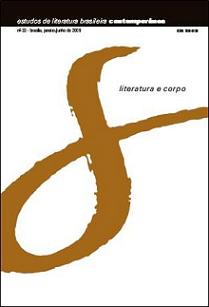O corpo e as tiranias do espírito na ficção contemporânea
Abstract
Num tempo em que os avanços científicos e tecnológicos estimulam, algumas vezes num diapasão eufórico, o imaginário do fim do corpo; num momento em que expressões como homem-máquina ou pós-humano aparecem com frequência na reflexão teórica, a dimensão corporal ganha, em narrativas ficcionais brasileiras, um certo protagonismo, seja como antídoto à decadência dos valores modernos, seja como lugar, por excelência, onde o poder inscreve suas marcas. Partindo dessa premissa, o artigo realiza uma leitura de textos de Sérgio Sant’Anna, Rubem Fonseca e Fernando Bonassi, visando destacar, em meio à diversidade de tratamentos do tema, a importância conferida ao corpo.
Downloads
References
BONASSI, Fernando. Passaporte. São Paulo: Cosac & Naify, 2001.
BOURDIEU, Pierre. Meditações pascalianas. Rio de Janeiro: Bertrand Brasil, 2001.
FIGUEIREDO, Vera Lúcia Follain de. Os crimes do texto. Belo Horizonte: UFMG, 2003.
FONSECA, Rubem. Confraria dos espadas. São Paulo: Companhia das Letras, 1998.
_______. Secreções, excreções e desatinos. São Paulo: Companhia das Letras, 2001.
LE BRETON, David. “O fim do corpo”. Jornal do Brasil, Caderno Ideias, 17 de março de 2001.
LÉVY, Pierre. O que é o virtual? São Paulo: Editora 34, 1996.
NIETZSCHE, Friedrich. Genealogia da moral: uma polêmica. Trad. de Paulo Cesar de Souza. São Paulo: Companhia das Letras, 1998.
SANT'ANNA, Sérgio. O vôo da madrugada. São Paulo: Companhia das Letras, 2003.
_______. A senhorita Simpson. São Paulo: Companhia das Letras, 1989.
_______. O monstro. São Paulo: Companhia das Letras, 1994.
_______. Um crime delicado. São Paulo: Companhia das Letras, 1997.
SCHNAIDERMAN, Boris (org.). Contos reunidos: Rubem Fonseca. São Paulo: Companhia das Letras, 1994.
Downloads
Published
How to Cite
Issue
Section
License
Authors who publish in this journal agree to the following terms:
a) The authors maintain the copyright and grant the journal the right of first publication, the work being simultaneously licensed under the Creative Commons Attribution License-Non Commercial 4.0 which allows the sharing of the work with acknowledgment of the authorship of the work and publication this journal.
b) Authors are authorized to enter into additional contracts separately, for non-exclusive distribution of the version of the work published in this journal (eg publish in institutional repository or as a book chapter), with authorship recognition and publication in this journal.
c) Authors are allowed and encouraged to publish and distribute their work online (eg in institutional repositories or on their personal page) after the editorial process, as this can generate productive changes, as well as increase the impact and citation of published work (See The Effect of Free Access).
d) The authors of the approved works authorize the magazine to, after publication, transfer its content for reproduction in content crawlers, virtual libraries and the like.
e) The authors assume that the texts submitted to the publication are of their original creation, being fully responsible for their content in the event of possible opposition by third parties.


